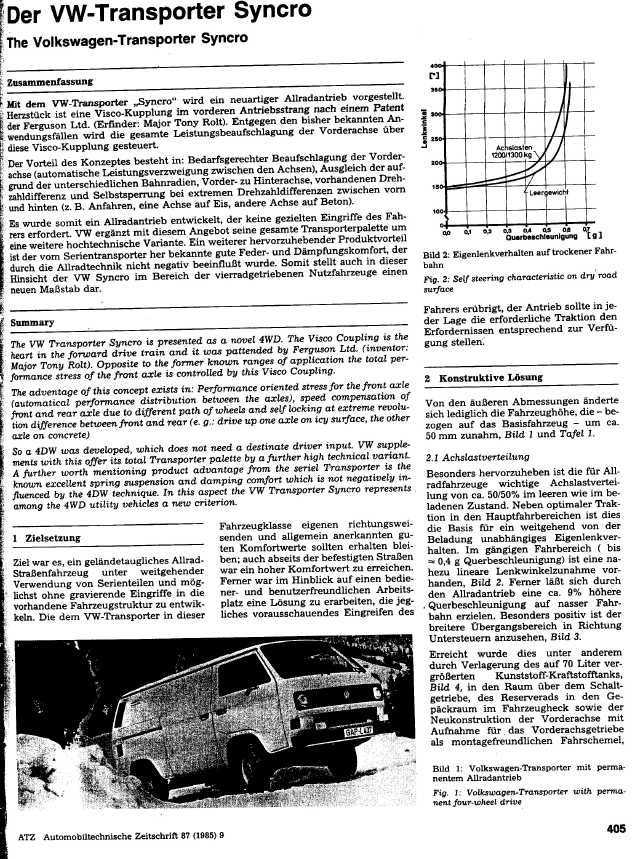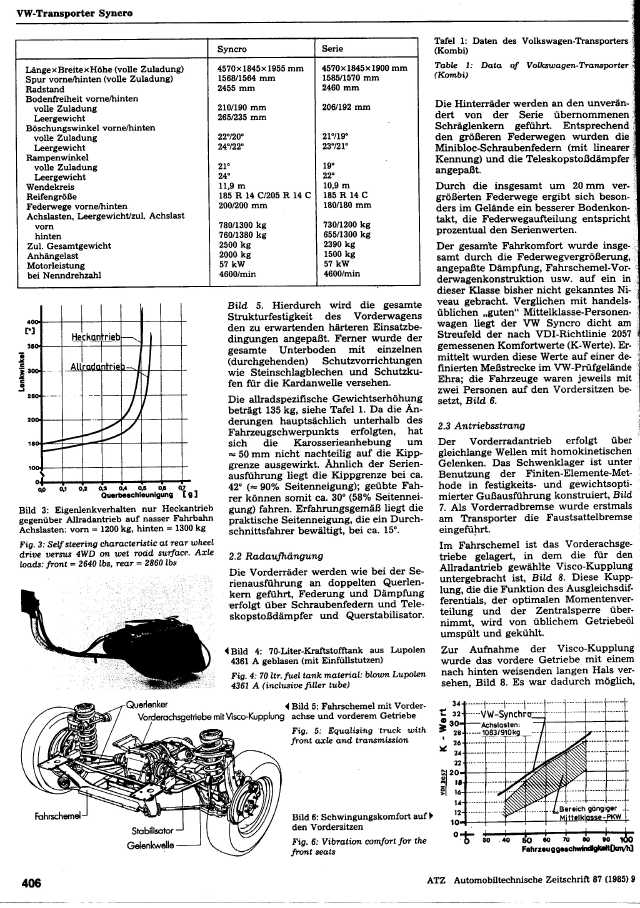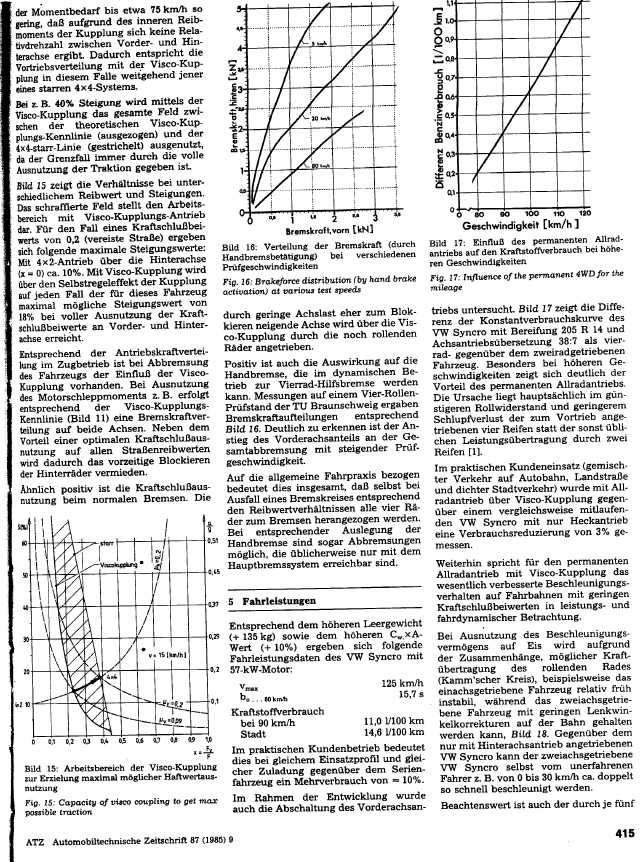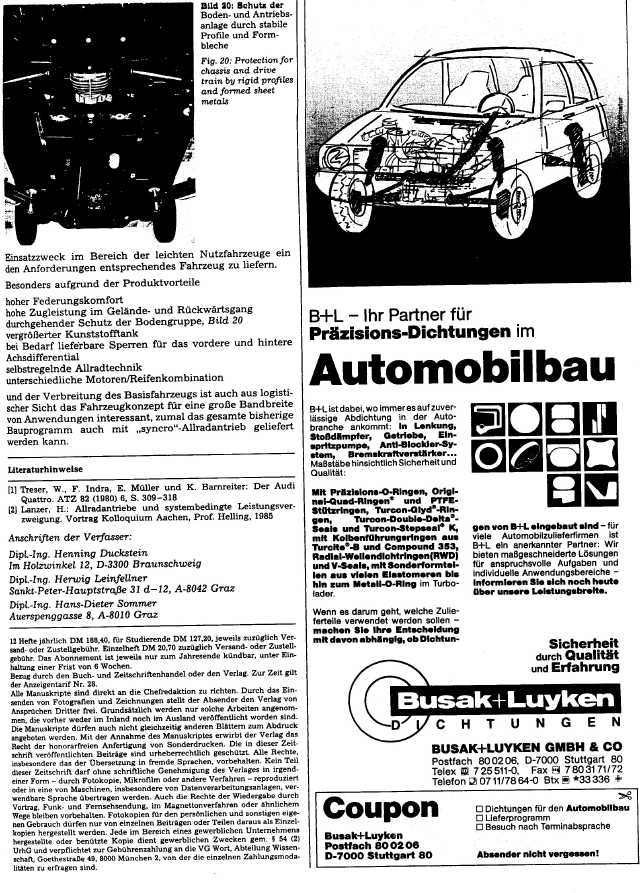Difference between revisions of "Syncro links page"
m |
|||
| Line 25: | Line 25: | ||
=Exhausts= | =Exhausts= | ||
=Transmission= | |||
=Wheels and Tyres= | =Wheels and Tyres= | ||
| Line 138: | Line 140: | ||
Obviously, check the battery condition, security and terminals/cable. If you can see the starter terminals, check that both main and solenoid wires aren't likely to touch the bodywork above starter, and look OK and well insulated (another potential electrical danger area) | Obviously, check the battery condition, security and terminals/cable. If you can see the starter terminals, check that both main and solenoid wires aren't likely to touch the bodywork above starter, and look OK and well insulated (another potential electrical danger area) | ||
See 'weaknesses' e.g. things that can break, show-stoppers etc | |||
Tools... | Tools... | ||
Revision as of 20:48, 11 January 2011
Repairs and Maintenance
- The Syncro 4 wheel drive system explained
- Do's and don'ts
- VC removal and refitting
- Prop-shaft removal, refurbishment and refitting
- Prop-shaft bush replacement Prop shaft ringing suppression
- Fuel Filter
- Petrol tank
- Diff-lock actuators
- Speedo diff drive gear replacement
- Front outer CVJ repair
- Front outer CVJ seals
- Gearbox and diff oil
- CV Boots - Front
- Steering joints
- Front diff-locks
Chassis
Bodywork
Exhausts
Transmission
Wheels and Tyres
- Tyres explained
- How big can I go
- Alternative rims and tyre combinations
- Syncro tyre rotation
- Tyre size/Gear ratio optimisation
- Wheel and tyre weight
- All Merc wheel data
Suspension
- Syncro suspension
Fuel System
Specifications
- Weights and towing
- General 4X4
- Wheel arches and mudflaps
- Differences between models
- Specifications - Oils
- Transmission specs
- Wading specs
- Other relevant off-road driving specs
Syncro specific parts
- General Syncro Parts
- Engine Parts (Syncro-specific)
- Gearchange Parts (Syncro-specific)
- Syncro Handbrake cable
Testing and buying guides
Syncro brochures and VW adverising
Syncro Websites
Syncro Differences
Off-Road Sites
Expedition vehicles
Preparations
Syncro lover: Off on my travels soon with my 1.6TD T25 Syncro... to Denmark and beyond?
What do I need to take and check before I leave
HarryMann: This is a hard question to answer if we don't know what you have done, checked, repaired or refurbed previously and what that van has been subjected to over the years. I'm sure you can understand that, but for starters...
Plenty of (proper Turbo-diesel spec) oil and an alternator belt.
If you expect any duration of a day or two on dry dusty tracks then a spare air-filter element, but start with a new or cleaned one, they can to an extent be knocked out and vacuumed or blown out.
A glo-plug fusible link (55 Amp?) for the junction box (see * below)
Check the injector return hoses look OK and are not soaked in fuel and that the injection solid pipes have the vibration restraint bands fitted (2 off) Check the turbo oil-feed pipe is also fastened to prevent vibration behind the cylinder head
Fit a new fuel-filter or at least drain the one you have, but watch the silly return connection on the top isn't/doesn't start leaking or letting air in the fuel circuit. Check your pump LDA is working (diaphragm) and she pulls well under load. Be aware of the expected coolant temperature needle positions at various speeds/loads and that the rad fan stages come on properly...
Additionally you don't say if you intend to drive off-road at any time, if so, to what extent and how challenging that might be.
So, if you are not 100% sure of the state of the shafts, take a complete rear shaft or if not possible, one spare std. CVJ with boot.
Definitely take the tools to tighten/remove a CVJ, so check if you have hex or 12-point or a mix of driveshaft bolts.
Check the steering rod rubber UJs for splits/perishing (two sets) under the bash plate.
A spare alternator or diode pack set isn't a bad idea too... and if there's any doubt about the starter motor, then ditto. These can all be packaged up in bubble-wrap nice and tight and fastened/jammed in the locker...
Check the auxiliary water pump is actually working.
Check all the exhaust manifold and turbo to manifold and turbo to exhaust bolts are tight, and that either of the silencer rubber mounts aren't split.
One of the biggest threats to a TD IMHO is the oil pressure and turbo seals condition... it's always a good idea to check the hot oil pressure in absolute numbers at idle and about 2,000 rpm before a long trip. .9 bar and a bar per 1000 rpm at higher revs when hot is good to go.
If oil is actually dripping rather than just oily underneath the turbo and sump drain area after a long hot run then not a good sign, but not unusual, a matter of degree!
Handbrake adjustment and rear brake condition and integrity.. a quick drum-off and de-dust and re-adjust isn't a bad idea.
Also a good idea to check the fan is coming on both speed stages and that the main rad is fairly clean and not blocked with a million flies.
A quick check when the bash-plate is off that none of the front water pipe joints are leaking also good.
If you can check the gbox and diff oi levels, or at least check the flange output shaft seals are not dripping leaking badly and there is not excessive whirl on those output transmission output bearings.
Take some dayglo slip-on jackets and hang them up behind the front seats, so POLICE can see you have them on-board, and a warning triangle easily accessible, as well as a fire-extinguisher than can be grabbed quickly - I have velcroed mine to the plastic mat between my seat and the door so I slide over it when getting in and out... but its still there two yeasr later (just!)
* Check the wiring for the glo-plugs from inside the junction box to the plugs - this is one of the most common causes of fire on Diesels, as that wiring is very tight, bunched and messed about with... any signs of overheating from the fusible link onwards then look closer.
Obviously, check the battery condition, security and terminals/cable. If you can see the starter terminals, check that both main and solenoid wires aren't likely to touch the bodywork above starter, and look OK and well insulated (another potential electrical danger area)
See 'weaknesses' e.g. things that can break, show-stoppers etc
Tools... Check your jacking points for corrosion and if unhappy take another type of jack. Take one or two hefty blocks of wood and a 9" x 9" plate of 3/4 or 1" ply A 1/2" or 3/4" sq. drive powerbar with a 19mm impact socket A club hammer, a good jemmy, a small terry saw, a pruning saw or axe also a good idea. A quality adjustable spanner of a decent size and again, quality Mole-grips with flat faces (not those useless curved jaw Chines copies) A reliable tyre pressure gauge, check them when cool in the morning and make sure you know what they should be for the tyre and load. An electric tyre-pump is not a bad idea either, if you are straying far from tarmac or dense civilization! (The round Michelin one is a good pump if you can get a deal on it (Halfords maybe?), but at £55 retail, is a tad expensive, the cheaper one without the removable gauge is what I've got, and excellent. An extra cigar -lighter socket somewhere in the back a good idea too.
The best tool of course is a guaranteed repatriation recovery service.. :wink:
Driving
If it tends to get very hot on climbs, then let it roll down the slopes before a hill as fast as it wants to chill-it as much as possible, letting the speed bleed off gradually as it climbs, coming down the gears rather than pushing too hard for too long - it'll be heavy! Ditto side or headwinds , don't push it! Again, if it tends to get very hot, stop at viewpoints/laybys when climbing up which'll let it cool rather than sticking it out to the very top... i.e. take photos and tea breaks on the way up :wink: Even if the revcounter sits at 4,000 or more, let the engine do the braking on long descents, I've not heard of TDs having problems due to revs alone and even the 1.9s don't mind 4.5 to 5k.
Have a nice trip and consider writing it all up for us when back :)
Amulet: Okay I'll try not to make this response too much like an essay...
I built a vanputor into my syncro about a year and a half ago. The main reasons behind it were that I was travelling through a number of different countries and wanted to run mutliple sat nav systems from one platform. The idea started to mushroom from there with the obvious other benefits that a pc in the van would bring such as big mp3 playback facilities, VAG interface to the ECU, web browsing, email, downloading digital pics from the camera when the memory gets full and the list goes on.
I decided to build a windows based 'car' pc. When I was researching everything (and it might have changed now) the following websites offered the best advice:
I found cartft to be the best value for components and sourced everything from the touchscreen monitor to the motherboard from them. Other bits like the VAG interface and software I sourced from the bottom two links and then just salveged two laptop 20GB hardrives which work a treat. The spec of the install is as follows:
- VGA Touchscreen monitor – in dash - Voom PC / Amphie Computer Case - M1-ATX Power Supply (important as prevents overloading when you crank your ignition if running of the main battery) - VIA M10000 Motherboard - RAM 512 DDR 400 - USB DVD ROM / CDRW Panasonic - USB GPS Reciever (SIRF3 Chipset) - Linksys USB Wireless Modem - 2X 20 GB harddrive - Windows XP Pro - Centrafuse (car interface management software to prevent squinting to use small pc icons) - Touratech GPS software - Memory Map GPS ordance survey - MS Autoroute
I'm not that techy but found it quite a simple job to do the install myself. It's been through some pretty tough terrain and stood the test well with 0 faults to report which is more than can be said for my ECU which went caput when put through the same conditions...!
Taken from the follwing 80-90 forum thread Camper thread on vanputers
Other Modifications
Prop-shaft sound damping
Application of self-adhesive bitumastic laminate (panel anti-drumming) to prop-shaft, to heavily damp natural bell-ringing mode
This was just an experiment. The prop surface was cleaned and degreased, patches applied carefully, overlapped lightly, cut through with Stanley knife and the butt-join made as firmly as possible...
Result.. quiet as a mouse :)
One of the laminates startied delaminating fairly soon
Edge of another started rising, so cut-off, s small bubble appeared (the bond de-laminating)
Overall, one survived about two or three months before I decided to clean-yp and remove (slight vibration returned)
This could be engineered better with strong over-banding or a different type of laminate to give a more permanent solution. Filling the prop with a high density foam might help to an extent with the internal organ-pipe mode amplification.
AWD Viscous couplings & decouplers
Forum Discussion
desert rat: I have just tested my VC (4x2 timber test) and it is a little tight as in it won't tick over as it just stalls the engine out!
Which is better - to fit a new VC or leave it tight and fit a Decoupler? Also most of the mileage this year will be done on the road!
SyncroSimon: Take the strain out of the system and get a de coupler, last time I had mine in 4wd was for the snow.
Mine is a tight VC and seems ideal for off roading. Do use it just occasionally for manoeuvrings on grass etc, climbing onto ramps.
In my opinion the front end when de-coupled will not wear.
Makes the handling better in 2wd. Forget about tyre rotation and buying 5 tyres at once. Peace of mind.
How the de coupler can cost so much is totally beyond me, all that is added is a shaft and a cog, plus a plunger. must be the worlds most expensive mechanical part. real rip off.
peasant: Just to be contrary :mrgreen:
The whole point of a Syncro IMO is the effortless safety of the automatic 4WD ...especially on the road. Yes, you can take it off road, but it's not an off-roading vehicle by design ...it was designed for poor roads and bad weather. I certainly get enough of both where I am and wouldn't want to miss the the 4WD.
Unless most of your road driving happens on motorways or very good roads, i'd buy a new VC (seenashow it costs roughly the same as a de-coupler anyway) and if 95% of your driving indeed happens on first class roads ...sell the Syncro, make a mint and buy yourself a superb 2WD.
syncrosimon: Yes, but I dont need 4x4 for 95% of the time, and do for the other 5%, so the decoupler is the best.
If you tried one you would never go back, I have as much fun in mine soft roading in 2wd with the reasurance that when she grinds to a halt I just pull the middle button out. Real test of driving skills.
The front end components are too expensive to wear out un necessarily on the motorway. If it is raining hard etc I pull the lever. More driver input more fun.
peasant: I would contest that a good VC actually makes the Syncro handle better than the 2WD ...even on dry roads (wet or slippery roads are no contest anyway)
I've had 2WD T3's for 15 years and the Syncro for two years now. The Syncro is a much "sportier" (if a diesel T3 can ever be sporty) drive than the 2WD. You can push it through tight corners much more forcefully than a 2WD.
All this off-road thing with the Syncro is great fun and a big boon, as it can go where no other van went before ...but do not neglect the on-road advantages of 4WD over it. I mean, Audi builds quattros for a reason, don't they?...and they don't usually go off road
IMO, by driving the Syncro with a stiff VC and a de-coupler you're crippling it and taking away from, not adding to its original design.
desertrat: Still confused by what to do? Do I fit a decoupler or a new viscous coupling?
I understand that having a decoupler would take the strain out of the front part of the drive train especially on road where you dont need 4wd! If I fitted a decoupler would i get a slight saving on fuel consumption or is that just another subject?
SyncroSimon: No saving in fuel as far as I can tell, I look at the decoupler as being kind to the front end, how much for cv joints and diffs on a 16"?
The new VC method is also good, but I prefer the decoupler, just being able to jack up a rear wheel and spin it is a real boon.
On these now fragile machines anything that aids longevity has to be a good thing.
Russel at Syncro-Nutz: You will make no saving on fuel.
The first setups did use a billet shaft. I was not referring to that part of the drive train. Using an old tight VC with a decoupler is not ideal as a stiff VC can slip under load. The two best options are a billet shaft or a sports VC.
Syncro drivetrain setups are a personal choice decided by budget and useage. There is nothing wrong with the VC setup and suits more people than the decoupler. The decoupler and billet or Sports VC is only for extreme traction which 99% of syncros will never need. I would think that the VC would suit you.
History
Major Tony Rolt, Derek Gardner, Ferguson Formula Developments (FFD), etc.
Must disagree the VC is a rare beast, unless you mean on the original Jensen FF system... But VC versions were subsequently offered with full mfr. approval and warranty to Opel's Senator, Monza and Bitter during the 1980's...
Their (FFD) milestone was the revolutionary viscous control unit which allowed a much better central differential slip control
with the benefit of being much more compact than its predecessor. It required less maintenance and much lower production costs
yet still utilised their Maxaret anti-lock braking system.
Both the aforementioned systems were marketed as 'All wheel control'.
Conversions of Senators, Monzas and Bitters by Ferguson Formula of Coventry were first offered to the general public in 1980
employing their novel & revolutionary viscous control unit. All the conversions were approved by their respective vehicle
manufacturers and therefore did not affect the warranty. As the cost of conversion was roughly 50% of the cost of the new car,
relatively few were produced despite excellent road test reports & results.
Some Granadas and Transits were converted, hand-in-hand with Ford. FF Developments subsequently offered it on almost any vehicle, including ambulances, and also for Dodge Challengers.
In the early 1960's, the successful front-engined P99 F1 car won at Oulton Park (Stirling Moss) in the rain, and even in dry practice was 2nd on the grid by just 2/10ths of a second and became the last front-engined car to win an F1 race, before mid/rear engined designs balanced axle loading more sensibly and then wings solved the grip problems many had experienced in 1968's wet, wet, wet season... Cosworth developed their own system at some point I believe, whereas several others used systems based on the FF e.g. Lotus.
Ferguson Research went on in racing, supplying the Novi-powered P104 to the STP team for Indianapolis.
Ferguson later supplied 4WD transmissions to various Indy and F1 teams.
BRM used the Ferguson 4WD system on the P67 in 1964.
Ferguson Formula Developments
The story behind Ferguson Formula Systems is an amazing one. It starts 30 years before the first production Jensen FF was born. Brooklands Riley racer Freddie Dixon (who worked with fellow Irishman Harry Ferguson) worked on a 4x4 for racing.
Being out and out racers, their only motive was to win races. They eventually met up with another driver, Tony Rolt,
a born innovator, PoW escapee and 24 Hour Le Mans winner. It was shortly after his Le Mans win that he and Ferguson started
development on what was to become the FF's predecessor, the P99. [b]Building a simple 4 wheel drive system is one thing,
but to build a 4 wheel drive system with unequal front/rear torque splitting, self locking centre differential
and to incorporate a Maxaret anti-lock brake system is an amazing achievement.
Rolt didn't consider his multiple escapes were 'fun' nor his lead-role in the Colditz 'Cock' Glider episode, but that escaping was simply a duty. He was in fact awarded a bar to his Military Cross for what was an incredible record of POW camp escapes, being lucky not to be summarily shot I should think!
He & his wife witnessed the tragic Le Mans accident where 80 people were killed, at which point he decided that working in vehicle development was a better contribution to society.
Quote: Telegraph Obituary
He subsequently built Indianapolis 500 track-racing 4WD cars for the American STP Corporation,
and Ferguson transmissions appeared in the Lotus, Novi, STP and Shelby Indy cars of 1964 to 1969.
With the technical director Claude Hill and the project engineer [b]Derek Gardner[/b],
Rolt was among the unsung backroom heroes of British racing development.
Ferguson Developments was closed when, after Harry's death and with the Ferguson family's blessing,
Rolt founded his own FF Developments company in 1971, converting cars, vans and ambulances to 4WD.
FFD became an important partner of Ford, Chrysler, Audi, Fiat/Lancia and General Motors.
In 1994 the business was sold to Ricardo.
Reading this following may imply that Derek Gardner first had the idea that a Viscous clutch could be developed into a self-locking coupling... or that Gardner proposed it be wrapped a round a planetary diff.
Tony Rolt, MD of Harry Ferguson Research, patented Derek Gardener's idea using Potty Putty as viscous coupling
for slip control as part of differential between front & rear drive.
Rolt sold 4wd patents to GKN to finance his new company Ferguson Formula Developments FFD.
The new Wolston factory provided capacity to meet the new Chrysler project. Oz Webb went as part of the package to GKN.
Os developed the idea into a working coupling using internally splined plates over centre epicyclic diff with slots & gaps in multiplates running in viscous fluid. Rolt's FFD retained the right to produce low volume 4wd & continue development.
The planetary centre-diff which locked a wrap-around VC when its shafts differed considerably in speed, was built and proposed for the production Scimitar GTE 4WD... but not fitted to the single prototype, allegedly now somewhere in Cheshire!
GKN retain the VC patents and much further development ensued with many production licenses sold. It's even been used across axle (LSD style) on some Japanese cars.
[HM]
Dangers & Safety
Other Documents and Links
Syncronauts' website
Go to the Technical menu on the 8090 Uk Syncronauts website







